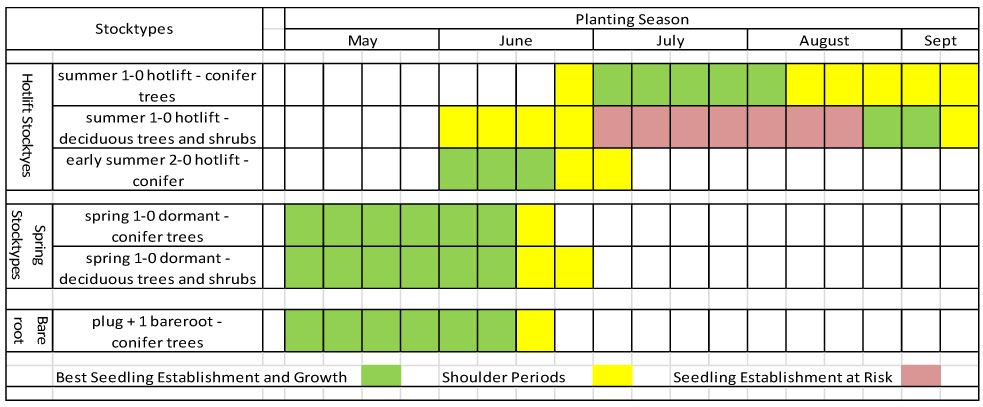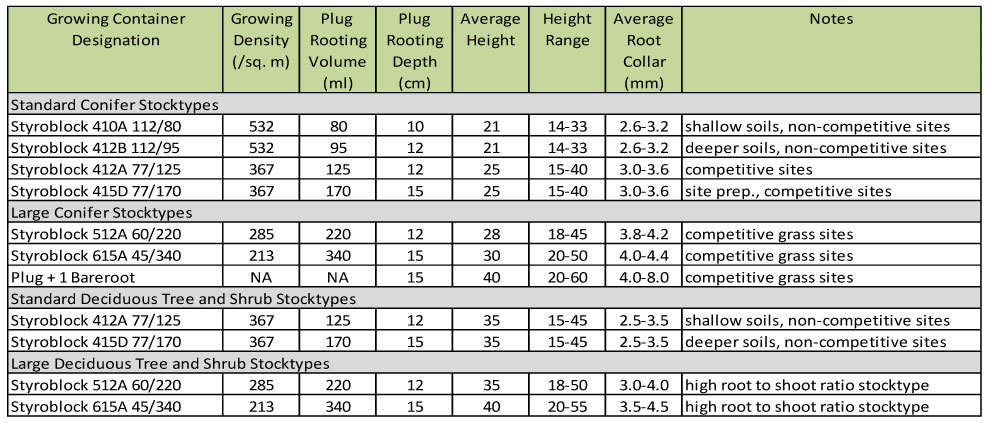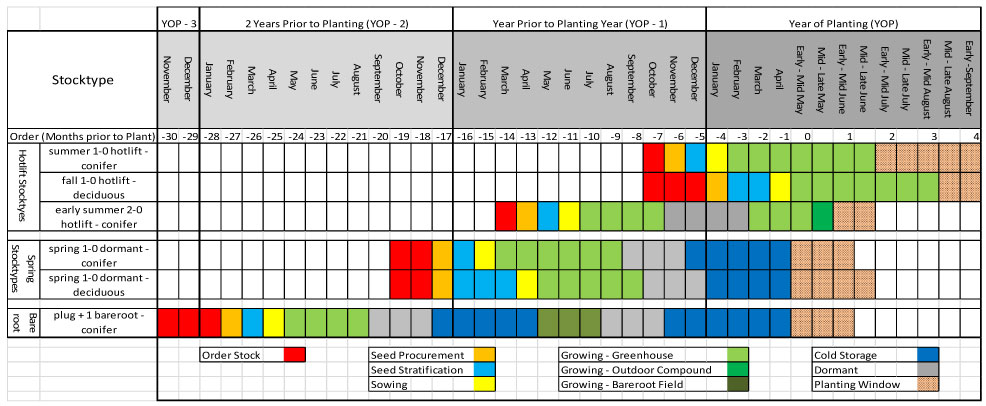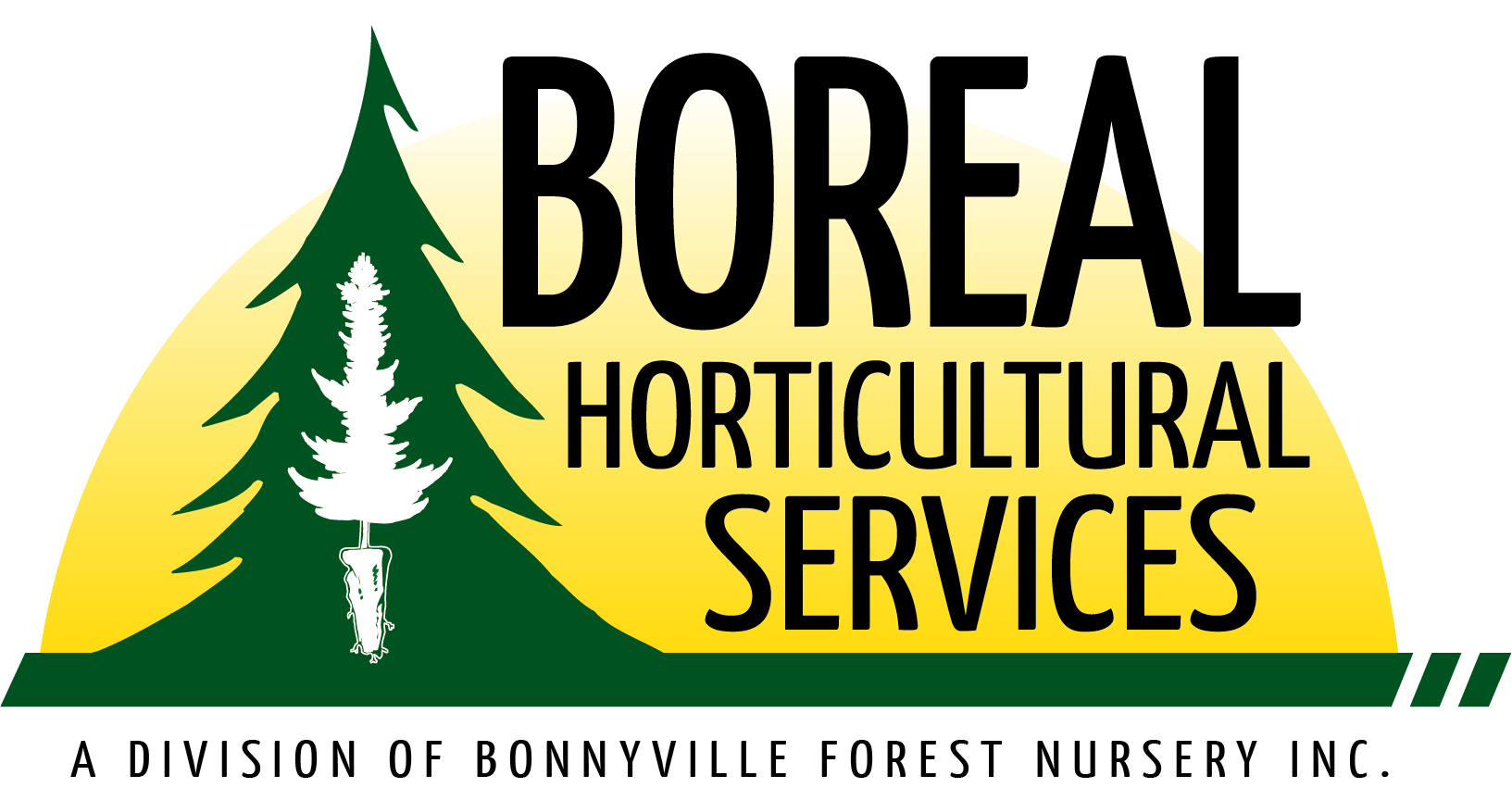Growing Schedules
Reclamation seedlings can be grown for either spring dormant delivery (early May to mid-June) or summer hotlift delivery (late June to mid-September). Conifer seedlings can be planted in spring or summer. Deciduous seedlings are best planted in the spring as a dormant seedling when there are no leaves present, outside temperatures are moderate and there is less concern about water loss. Alternatively, deciduous seedlings can be planted in late summer and early fall, after they have set bud.

Planting Windows Table
Spring 1-0 dormant seedlings
Spring seedlings were grown in the greenhouse the previous year, harvested and packed the previous November and December, placed in temperature-controlled (-2 to -3) freezer storage for the winter and kept there until requested by the customer in the spring (usually late April, early May).
Spring seedlings need to be planted no later than June 15 so that the seedling has sufficient time to break bud, grow, set bud and be physiologically ready for winter.
Advantages
- Planted when growing conditions and moisture are favourable i.e. getting warmer while there still should be good soil moisture from snowmelt.
- Best time to plant dormant deciduous stock, before seedlings have leafed out.
- Will break bud and grow, so you will see some growth after planting.
Disadvantages
- Spring weather and soil conditions may not be favourable for planting (e.g. cold soil temperatures, excessive soil moisture).
- New shoot growth is susceptible to spring frosts.
- Seedlings must be planted no later than June 15.
Summer 1-0 hotlift seedlings
These seedlings are planted the same year they are sown in the greenhouse. Seedling shoot dormancy has been induced before they leave the greenhouse in the summer. The earliest period that current crop summer hot lift seedlings can be delivered to the planting site is late-June. Depending on the client’s requirements, hotlift seedlings can be delivered until early-September. Since shoot dormancy is induced prior to being shipped to the field the seedlings will not have any further shoot growth the summer of planting, but will instead direct their energy into establishing their root system. They will be ready to break bud and grow the spring after planting.
It is very difficult to induce sufficient dormancy and hardiness in deciduous stock to allow for successful establishment during the summer (July to mid-August) months. If a mixed conifer/deciduous plant is required for the summer, it is preferable to plan these projects for late-August to early-September when the seedlings are going into natural dormancy.
Advantages
- A shorter production period compared to spring seedlings (see Tree and Shrub Growing Regimes and Ordering Timelines).
- Provides another planting period after spring seedlings. This is useful if the client has a very large order and can’t get it all planted in the spring planting period. A portion of the order can instead be planted in the summer.
- Provides the seedling time to grow roots into the soil before active shoot growth occurs.
- The seedling does not have actively growing shoots that may be susceptible to early fall frosts.
Disadvantages
- Seedlings could suffer if there is little rainfall after planting.
- Seedlings shoots do not grow the season of planting so no height increases.
Plug + 1 Bareroot seedlings
These seedlings spend their first growing season as container stock in the greenhouse. They are then overwintered in freezer storage prior to being planted the next spring in a nursery field for their second year of growth. At the end of the field season, the seedlings are lifted into freezer storage. During harvest from the field, all of the soil is removed from the root system, hence the name bareroot. The seedlings are planted dormant in the spring of the third year. This growing regime produces large robust planting stock that is suitable for planting on sites where aggressive herbaceous competition can be expected.
Advantages
- A large robust planting stock suitable for competitive sites.
- Planted dormant during the spring planting window when moisture conditions are favourable.
Disadvantages
- The production period and ordering timelines are longer than for container stocktypes.
- Must be planted during the spring planting window prior to June 15.
- More susceptible to damage from poor stock handling practices.
- Many planters do not have experience with the bareroot stocktypes
- A larger plant with a larger root system is more difficult and time-consuming to plant than a 1-0 seedling.
Seedling Specifications
There are a number of factors to consider in determining the characteristics of the seedlings needed to successfully establish on your reclamation site:
- The presence of herbaceous vegetation competition.
- Soil depths
- Soil moisture regimes.
- Site preparation treatments.
- Exposure to environmental conditions causing winter desiccation.
If the site has been seeded or has been colonized by herbaceous vegetation, larger stocktypes may often be required to compete with the vegetation. On other sites, with exposure to solar radiation and wind during the winter period a smaller stocktype might be more suitable. If a site preparation treatment such as mounding has been employed to provide a raised planting microsite, a stock with a deep plug might be chosen.
Click here to learn more about Beaver Plastics Styroblock Container Growing Systems.

Seedling Specification Table
Timeline for Ordering
Most seedlings for reclamation are grown specifically for the client as we rarely have large numbers of seedlings available for a specific seed zone at the last moment. We need a certain amount of lead time, especially if we need to source seed from another a specific seed zone. Refer to Tree and Shrub Growing Regimes and Ordering Timelines for the required planning times. The sooner you order your seedlings for a job, the sooner we can have them ready.

Tree and Shrub Growing Regimes and Ordering Timelines
Call us to discuss your Seedling & Reforestation Needs
